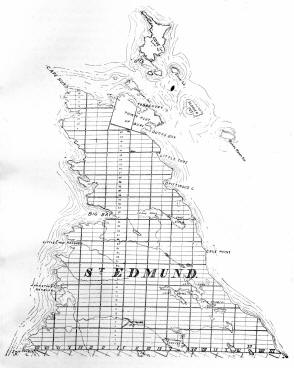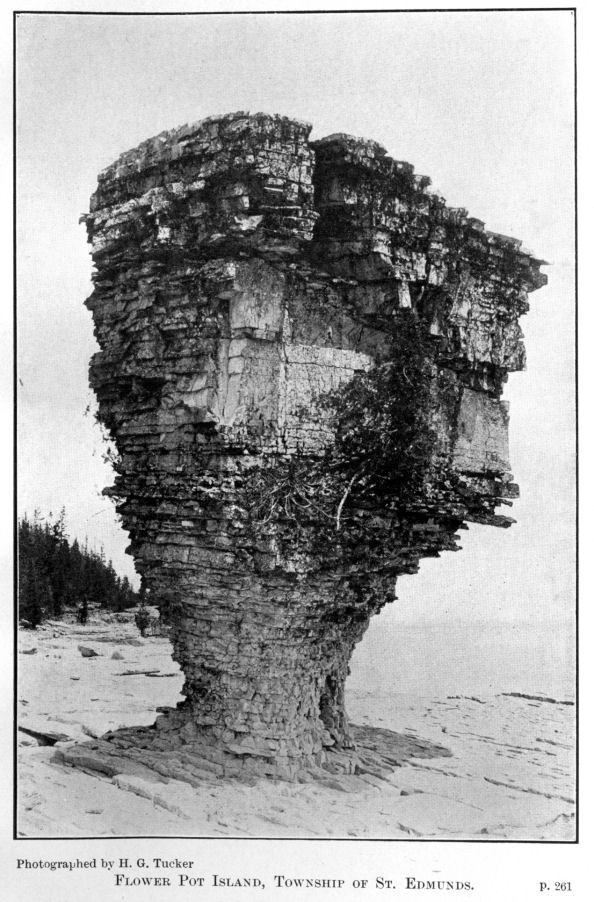|

This township is named
after Bury St. Edmunds. There has been from the first a disagreement as to
the spelling of the name; the Toronto Government officials giving "s" as
the final letter, and the Indian Land Office, Ottawa, spelling it without.
The township, on its becoming incorporated, adopted the former method of
spelling and calls itself "St. Edmunds.''
The chapters in this volume
which give the history of a township are in each instance prefaced by
extracts from the report of the county valuators, with the solitary
exception of St. Edmunds. For such information referring specially to St.
Edmunds as is to be found in these extracts the reader is referred back to
the preceding chapter, because the valuators in every report have joined
Lindsay and St. Edmunds together, and it is impossible to separate the
general remarks of the valuators and apply specially to Lindsay or St.
Edmunds.
Although further north than
Lindsay, St. Edmunds seems to have been but little behind it in receiving
its pioneer settlers, it being in the summer of 1871 that Captain John
Charles Earl settled at what is known as "The Big Tub." [The perfect
safety with which vessels could lie in the basin at Tobermory has made it
a much frequented harbor of refuge. For the convenience of navigators,
Captain Earl made a practice of hanging a lantern at the top of a high
pole as a range light and so ensure safe navigation to vessels when making
the harbor. He was remunerated for this service by various captains, they
presenting him with useful house supplies, such as a bag of potatoes,
flour, or some coal-oil, etc. In the course of a few years the Government
acknowledged this service and paid him a salary of about $30 a year.] In
November of the same year Captain Earl had a companion come to share the
loneliness of his pioneer life in the person of Abraham Davis, who settled
at Dunk's Bay. These pioneers were joined at various intervals, in
somewhat of the following order, by Captain Alexander Marks, Michael
Belrose, Jacob Belrose, George and Neil Currie, Robert, John C. and James
H. Hopkins, Thomas and George Bartman, Benjamin and Alexander Butchart,
Donald McDonald (first postmaster at Tobermory) and Benjamin and William
Young. Mr. Solomon Spears (to whom the author is indebted for many of the
facts connected with the history of St. Edmunds) settled in the township
in March, 1883. The
lumbering resources of St. Edmunds have been exploited to an extent not
equalled in any other township of the county. In 1872 Cockwell & Grant
erected a large saw-mill and shingle-mill on the Crane River, at what is
now called "McVicar's." This firm cut a road from Pine Tree Harbor through
the woods for a distance of ten miles to a point at which they built their
saw-mill; they also laid out a large sum in cleaning the river so that the
produce of their mill might be floated down to the harbor. This mill and
its limits were purchased in 1880 by Peter McVicar, [Peter McVicar
continued the running of this mill for twenty years, when, in 1901, he
retired to spend his declining years at the town of Perth. Mr. McVicar was
the first reeve of Carrick, in 1856 and 1857, and also the first reeve of
the united townships of Lindsay and St. Edmunds in 1883.] who built
another mill in the following year as well as a wharf at Johnston's
Harbor. In 1881 a mill was built at Tobermory by Messrs. Maitland & Rixon.
This mill was burnt down in March, 1883, but rebuilt in the same year by
the same firm, who after running it six years moved it to Owen Sound.
About 1892 the Southampton Lumber Company built a saw-mill at Pine Tree
Harbor. In 1895 a mill was built at Tobermory by Richard Badstone (since
purchased and run by Hector Currie). In 1900 another mill was erected by
E. M. Meirs, and another in the following year by Messrs. Simpson &
Culbert, which gave Tobermory three saw-mills in constant operation,
adding materially to the trade of the village.
The post-office at Tobermory was established
in 1881, the mail being carried on foot from Stokes Bay. Mr. Benjamin
Butchart was the first mail-carrier. St. Edmunds' first school was opened
in 1883, Its first Board of Trustees were Michael Belrose, Donald McDonald
and Jacob Belrose. The first teacher was a Miss Ella Conklin.
As a separate municipality St. Edmunds has
existed since the 1st of January, 1903. Its previous municipal relations
are related in the preceding chapter, referring to the township of
Lindsay. The first reeve of the municipality was Solomon Spears, who also
filled the office in 1906, his successor for 1901 and 1905 being William
Simpson. The clerk of the municipality was James Campbell and the
treasurer John C. Hopkins.
The first public religious service in the
township is said to have been conducted by a Presbyterian student,
possibly a Mr. Peter McLean, who was the first to preach in Lindsay. The
first regular stationed minister belonged to the Methodist Church, the
Rev. Robert Walker. Succeeding him was the Rev. Mr. Sparling. Under his
ministration a church was built at Tobermory Harbor. The next minister was
the Rev. W. D. Dainard, who was instrumental in the building of a church
at "The Settlement," a point on the Bury Road some two and a half or three
miles south of the harbor. There is also a Baptist church at the town plot
of Bury, but the author is not able to give the year of its erection.
St. Edmunds being at the extreme north of the
peninsula nearly all the vessels passing into the Georgian Bay sail along
its coast. This has necessitated the erection of several lighthouses. The
first one to be erected was that at Cove Island. [After being in charge of
Cove Island lighthouse for twenty-five years, George Currie retired in the
summer of 1903. He was succeeded by Kenneth McLeod, of Tobermory.] This is
a white, circular stone building, built in 1859, which in addition to a
powerful light is also equipped with a fog horn to indicate the locality
when fog covers the water. The lighthouse at Tobermory was erected in
1885, and the one at Flower Pot Island in 1897.
In regard to the local names in St. Edmunds
the following comprises all the information the author has been able to
obtain: Lake Kent on the maps, but locally called Lake Cameron, is named
after John Cameron, of Southampton, a man well known to the Indians and
fishermen throughout the Peninsula in the days before settlements were
formed. Lake Cyprus received its name from the island in the Mediterranean
Sea, the name being given at the time that island was ceded to Great
Britain. Tobermory was named by the Highland fishermen after a town in
Mull. (In Bayfield's chart it is named "Collins Harbor.") The three lakes
on concessions 5, 6, 7 and 8, east of the Bury Road, were intended to bear
the names of the patron saints of England, Scotland and Ireland. This was
carried out to the extent of St. George and. St. Andrew, but a young man
named Emmett Smith, working in the office of B. B. Miller, the Indian Land
Agent, persuaded Mr. Miller to let one of the lakes be called after him,
so as Lake Emmett it will probably be always known. Bury town plot is
named after Viscount Bury, Superintendent-General of Indian Affairs in
1855. The entrance of
the telegraph and telephone wires into Tobermory has brought what was the
jumping-off place of the county into touch with the rest of the world, and
if the proposed railway ever reaches there we shall look for great things
in the township of St. Edmunds.

There are extensive caves to be seen in St.
Edmunds. The limestone rock, so common throughout the peninsula, seemingly
has here suffered from the erosion of water more than elsewhere. Possibly
the largest of these caves is to be seen on Flower Pot Island, the extent
of which is not known, as it has not been fully explored. The island takes
its name, that of "Flower Pot," from a peculiar shaped rock standing about
fifty feet in height. The illustration here given shows what a natural
curiosity it is and how appropriate is the name. |

